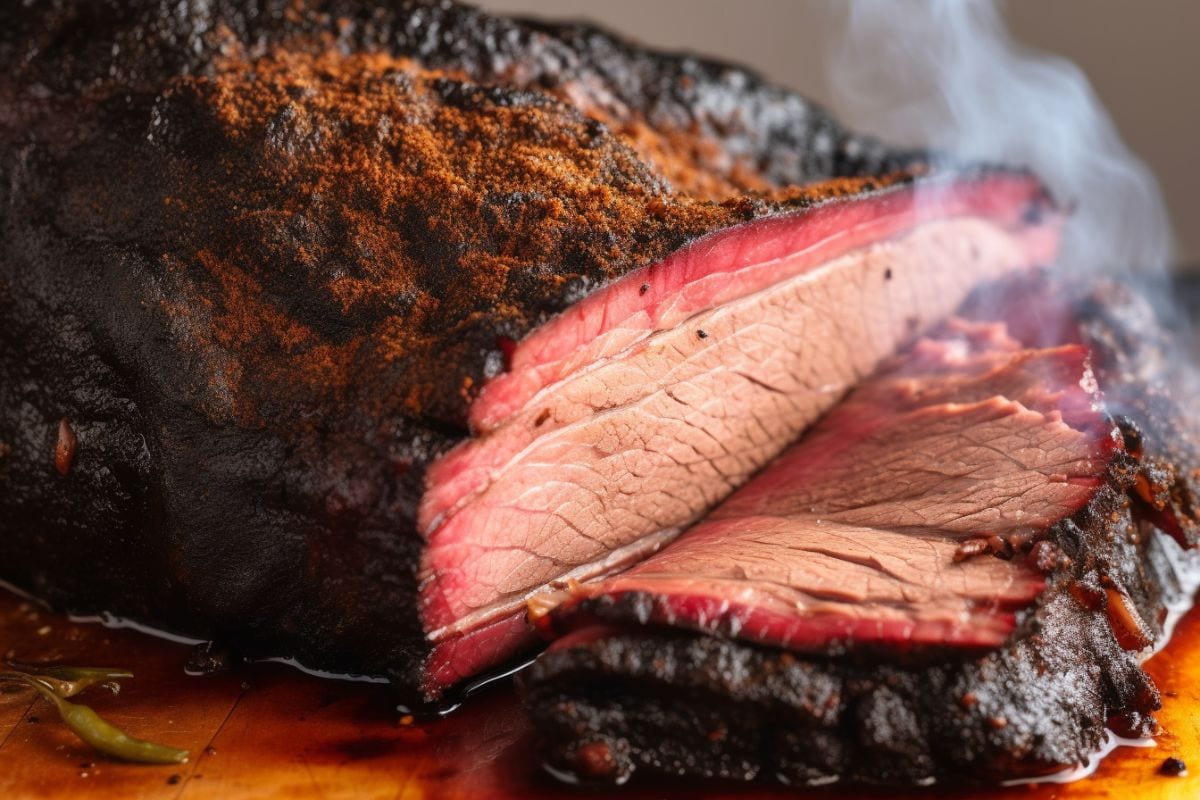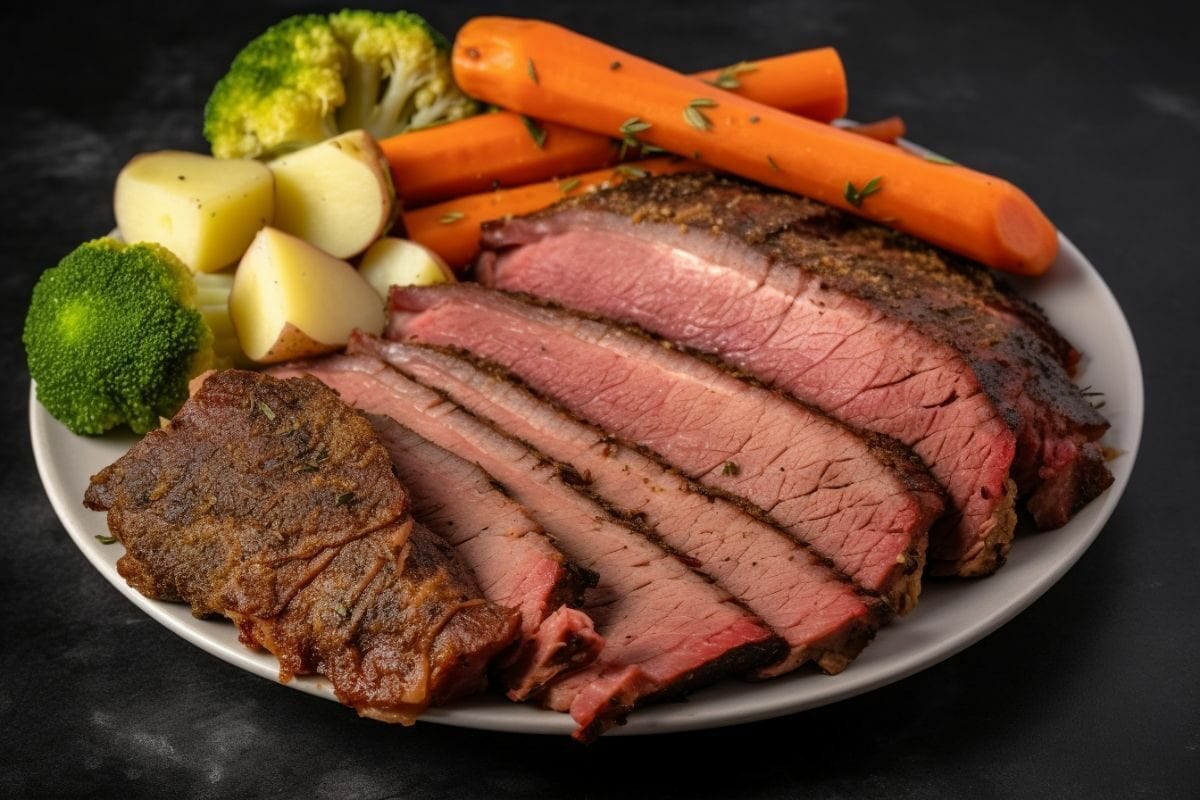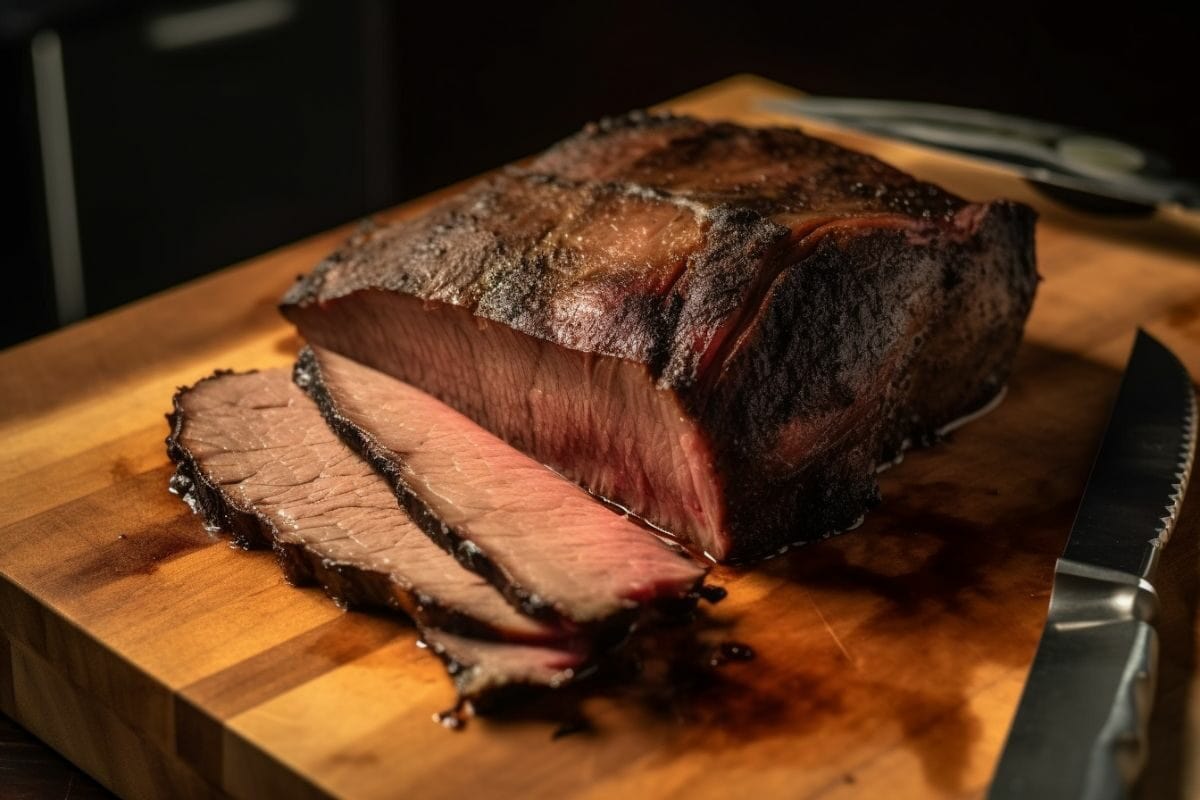If your brisket is coming out tough, there are a few possible reasons: it could be a bad cut, you’re cooking the brisket at a too high a temperature for too long, you’re not resting the brisket for long enough, and more.
Coming from a BBQ-loving family, I learned to make brisket as a kid. I’ve got brisket in my blood. My family taught me the dos and dont’s of smoking brisket. Cooking a brisket that turned out tough earned me chores – you better believe I figured out how to make it juicy and ultra-tender.
In this post, I will outline the top causes of tough brisket and show you how to avoid them. Let’s begin!

Here are the top reasons that your smoked brisket turned out tough:
A whole brisket is my favorite cut of meat in all of BBQ-land to cook. The marriage of leaner flat, and fatty point is a match made in heaven.
A whole-packer brisket is made up of two different muscles – again, the flat and the point – and it’s a whole brisket that’ll give you the most success when smoking.
If you aren’t smoking a whole brisket, try to buy a point. The point is a good option if you’re looking for a smaller cut because it has plenty of fat. The fat cap takes the brunt of the heat, so the meat is cooked at a low and slow rate. And the intramuscular fat renders down into juicy, tender goodness. It’s the finest cut of meat on the cow, in my opinion.
The flat cut is more readily available, but it has a lot of lean meat on it. It’s difficult to smoke tender brisket when you only smoke the flat. Make friends with your butcher, and try to source some point.
Related Reading
Stay away from USDA Select – the best brisket comes from the best grades. Grab Prime or Waygu if you’ve got the dough, and Choice if you’re on a budget. Select lacks the marbling and richness that you’ll need for next-level brisket.
Buying cheap meat that lacks enough fat to stand up for a long cook is a huge reason people complain about tough brisket. Don’t let that be you – spend the extra cash for a good grade.
A dry brine does two important things. First, it helps to tenderize the brisket so that it is broken down more easily when smoked.
Brining is also great for helping the meat to maintain its moisture levels. So you get a nice, tender brisket.
A lot of people skip the brining process or don’t know about it. Don’t let that be you! Use ½ teaspoon Kosher salt per pound of brisket or ¼ teaspoon table salt per pound. Let it sit on the refrigerated meat for at least 2 hours, up to 24.
Once you’re done brining, here’s what to do – without washing the salt off, add the dry rub. Then smoke the meat. It’s criminal how easy and effective dry brining is!

It can take 12 to 14 hours, or more, to hit 203°F (my ideal doneness temp) when smoking a whole brisket at 225°F. That’s a long cook – get comfortable and grind it out. Don’t take shortcuts if you’re brisket is tough.
Look, brisket is a naturally tough cut of meat.
It’s because it comes from the pectoral muscle – the part of the cow that supports up to 60% of the animal’s weight. Because of this, brisket has more connective tissue than other cuts. This connective tissue contains a component known as collagen.
The only way to break it down to get tender brisket is to expose the meat to low heat for an extended period of time.
So, if you don’t cook brisket for long enough (or to the right internal temperature), the connective tissue isn’t going to have time to break down. Therefore, you will be left with a tough brisket. There’s nothing sadder in the world of BBQ than tough brisket.
Low heat is the way to go, particularly if you’re new to brisket or BBQ. I would suggest that you set the temperature to 225°F. It has brought me, and many in the ‘que community, the most success.
I find that there isn’t too much of a difference if you take the temperature up to 250°F, but I would suggest that you keep a closer eye on the internal temp.
Don’t go beyond 250°F, however, unless you really know what you’re doing and you’ve got a Prime or Waygu grade of brisket.
When cooked low and slow (225°F) to 203°F, the tissues will have broken down long enough for the brisket to be nice and tender.
Related Reading
There are folks in the ‘que community who smoke brisket at 275°F or even higher. Hot and fast brisket gets cooked at 300°F. You need to be a seasoned pit master, and you need to buy a premium (Prime or Waygu) grade of beef to do this. This is an advanced technique. If you’re new to BBQ, don’t try it.
I get it. A full-packer brisket can be over 15 pounds, and you can easily spend up to 14 hours (or more) smoking the brisket. Add a rest, you’re looking at 18 hours. The temptation to nudge the temperature up is a real one.
The problem with this is that it cooks the meat too quickly, and the intramuscular fat doesn’t render. Brisket thrives when cooked at 225°F.
You need to cook your brisket to a very high internal temperature (I aim for 203°F). This is when the connective tissues and fats in the cut fully render, and the meat is toothpick tender. (A toothpick or probe will slide into the brisket with almost no resistance.)
If you are planning on smoking the meat according to time, think again. There are a whole range of factors that can impact the length of the cooking process. This includes the size of the cut, the smoking temperature, the weather conditions, and more. Times are estimates. Temperatures, less so.
Make sure to track the internal temperature every step of the way. You can do so by inserting the probe into the thickest part of the brisket. This will give you the most accurate results.

You can choose to leave the probe in the meat (if it’s a leave-in or smoking thermometer) or to check the internal temp at intervals (every hour or so).
Double-check the temperature by removing the probe and inserting it in a spot nearby.
If you want to know when the brisket has reached the stall, is close to being done, or is actually cooked, then you need to track the internal temp. For that, you need a good thermometer. Next to your grill, it’s the most important grilling tool you can invest in. It’s the best way to guarantee a properly smoked brisket.
Wrapping brisket is a contentious topic – I’m in the pro wrap camp.
I’m walking over hot coals mentioning it – I know a lot of pitmasters who prefer to wait out the stall rather than wrap the brisket. In doing so, they are able to get a hard bark that many pitmasters crave.
But when you don’t wrap the brisket, you are exposing the meat to heat for a longer period of time. This causes the meat to lose more moisture during this time. The final result can be a tough brisket.
Wrapping creates a moist cooking environment (throw a flavorful liquid or some butter in there), so you are gently braising the brisket. I wrap my briskets, as do almost all competition BBQ teams and many BBQ joints.
When the internal temp of the brisket reaches 150°F to 170°, the meat will stop climbing in temperature. It’s time to remove the brisket from the smoker and wrap it.
You will need to choose between butcher paper and aluminum foil. Foil is great for a slightly speedier cook as it is impermeable and traps more heat.
There is also less chance of a tough brisket as there is more liquid trapped inside, hydrating the brisket. The only downside is that you may end up with a softer bark.
If you want a better bark, choose butcher paper, as this material is more breathable. It will take you a bit longer to cook your brisket, though. When I wrap (which is almost always), I use paper.
There is no exact period of time to rest brisket for, though I like 2 to 4 hours. Many cooks rely on the size of the brisket.
A full-packer brisket that is around 12 lbs or more should be rested for upwards of 4 hours (some cooks rest for 6 hours). Smaller briskets can be rested for between 2 to 4 hours.
Regardless of the size of the brisket, though, make sure that it is rested for at least an hour, preferably 2.
To rest your brisket, stick it in a cooler for 2 to 4 hours before slicing and serving. I wrap mine in clean towels to help it retain heat.
I get why you want to skip the rest! Your beef brisket has already taken long enough to cook. The urge to cut into it shortly after removing it from the smoker is a powerful one. Resist!
See, as the brisket is smoked, the tissues contract releasing the moisture trapped inside. This moisture then travels to the surface of the meat. Some of it evaporates during the smoking process but not all of it. As the brisket cools down, the tissues relax, absorbing much of that moisture back.
If you slice brisket before it has had time to rest, it’ll be tougher.
Related Reading
Slice the brisket (and all meats) against the grain (opposite the direction of the muscle fibers). Slicing against the grain makes the meat taste more tender. It shortens the muscle fibers and makes the meat easier to chew.
You’ll need to figure out the direction the grain is running. This is easier to do with raw brisket but is still possible with cooked brisket. Look at the direction that the long strands of the brisket are running. This is the grain. Cut against it. It can help to make a note of the grain on the raw meat – snap a picture with your phone to help you remember.
The flat and the point have a grain that runs in different directions. You will first need to separate the two sections, identify the grain, and then cut against it. Cut the flat into pencil-sized widths and the point into thumb-sized widths.
Check out this youtube video if you’re stuck.
So, let’s say that your smoked brisket is done, and it’s as tough as shoe leather – is there something that you can do to fix this problem? Your best bet at fixing a tough brisket is to work with what you have by cooking it in liquid. This lets the meat absorb this moisture and soften up.
What I like to do is to take brisket slices and place them in a roasting pan along with sliced onions and peppers. Then, I add beef broth – you can also use some red wine. The acid can help to break the meat down. Cover in foil. Use 2 cups of liquid per 10 pounds of meat.
I preheat the oven to around 300°F and cook the meat and veggies for about an hour. Since the brisket is already cooked, you’re just trying to get it to absorb the beef broth. You know the brisket is done when the brisket slices are practically falling apart.
Stick some meat between two buns, and heap the onions and peppers on there, and it is absolutely delicious.
You can braise the brisket in beef broth using a Dutch oven too. It is all about adding liquid and letting it seep into the meat for around an hour. This method works for leftover brisket as well!
Note: no need to rest brisket after it’s cooked again in liquid – dive in!
Related Reading
Yes, cooking the brisket for too long can also cause it to be tough. Cook it past a temperature that feels like a knife going into hot butter when you probe it, and you start to lose moisture. You should only cook it until it is toothpick-tender.
Related Reading
Brisket is too expensive and tasty to screw up. If you are tired of tough brisket, then this guide is your saving grace for juicy, tender beefy perfection! Just follow all the tips and tricks here, and you should be able to serve up the perfect brisket every time!
Buy a brisket with a higher USDA grade. Smoke the brisket at 225°F until it hits 203°F internally. Rest it in a cooler for 2 to 4 hours. Slice the brisket against the grain, and you’ve struck Texas black gold, baby! Time to cook!